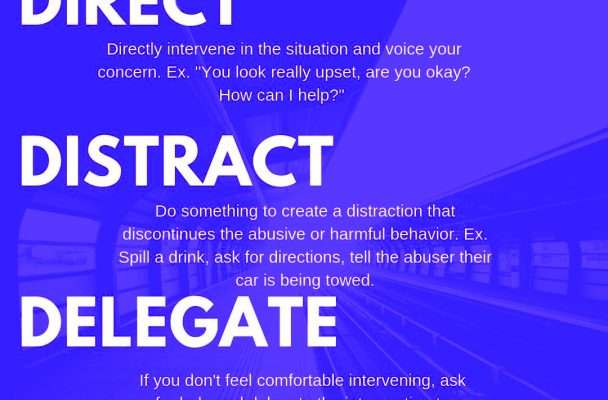Green Dot Program aims to prevent violence

The three Ds help to prevent violence.
Photo by Ospshasta.org
By Nicholas Bainbridge
Editor in Chief
Scott Wojciechowski, assistant vice president for Student Life, presented High Point University’s new Green Dot Program at the Plato S. Wilson School of Commerce Ballroom on Jan. 23 to members of HPU staff.
Green Dot is an initiative aimed at preventing violence on campus through bystander intervention. The name of the program relates to a mapping of incidents on campus marked by red and green dots, with red dots indicating instances of violence and green dots representing moments where someone intervened to prevent a red dot situation.
The national mapping system was originally created to keep track of instances of sexual violence; however, Green Dot is trying to expand on it and apply it to a broader range of instances, such as non-sexual physical violence and harassment.
Wojciechowski explained that the official mission of the program is to “create a campus culture where interpersonal violence is not tolerated and everyone is expected to do his or her part.”
Wojciechowski noted that bystander intervention can be difficult because of boundaries such as uncertainty or fear for one’s own safety. He explained that no harm may come from merely checking up on people to make sure that they are okay.
To address the issue of uncertainty, he pointed out signs that people can look for to try to assess the situation.“You might not see acts of sexual violence or other forms of abuse, but there are warning signs to look for,” said Wojciechowski.
“Examples would be if students’ demeanors suddenly change, they start turning in assignments late, they look disheveled or get new bruises. Sometimes the signs might be present without any abuse, but this should not stop you from checking in on them.”
When it comes to the issue of safety, he stressed that the Green Dot Program is not meant to impose a high enough level of obligation on people that would get them to endanger themselves. If one is fearful for their own safety, simply calling campus security from a safe distance would be sufficient.
Wojciechowski outlined “the three Ds,” the options people can take when they see a red dot incident. The first is a direct response, where one interferes with the altercation or aids the victim, such as checking on the victim or physically positioning oneself in between the victim and offender.
The second is to distract, where one does something to divert the attention of the offender, diffuse the tension of the situation or give the victim an opportunity to flee. One could simply walk up to the altercation and try to start a conversation, or if the incident is in a parking lot, setting off one’s car alarm would get enough attention to distract most people. Last is delegation, where one attracts the attention of others to get them involved in the prevention effort.
The Green Dot Toolkit is a document written by Dr. Dorothy J. Edwards, a researcher and president of Altruistic, the organization that originally developed the Green Dot Program. A major aspect of its instruction is that doing one’s part in bystander intervention does not always have to be a grandiose act. Simply being present and calling people out for bad behavior can make a difference.
There are multiple ways people can report abuse or get help. Across campus, there are blue emergency poles which can be used to call campus security immediately. Alternatively, security can be called at (336) 841-9111 for emergencies or (336) 841-9112 for non-emergencies.
HPU Care Alert is a program focused on helping students who are struggling with academic, social and personal problems, and can be reached through email at Care@highpoint. edu for help.
People can make anonymous referrals to Care Alert if they think one of their peers is struggling without fear of complicating their relationship. There is also the counseling center on the third floor of the The John and Marsha Slane Student Center, where students can speak with people trained to help those struggling through emotional, behavioral or psychological problems, regardless of whether they are caused by abuse or not.